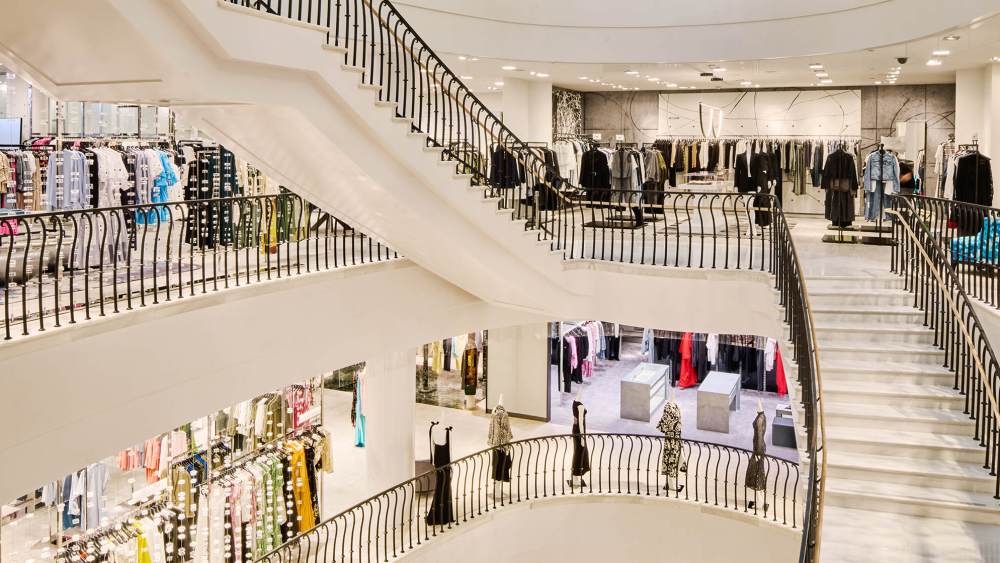Where does Saks Global go from here?
While fashion’s year started off with uncertainty around how Saks would integrate Neiman Marcus and pay off its past due bills, the attention shifted last month to U.S. President Donald Trump’s dramatic run up in tariffs.
The trade war has at least cooled, but the uncertainty at Saks has started to heat back up.
The turmoil in February was sparked by Saks’ plans to pay vendors more slowly going forward and its yearlong schedule to cover back payments starting in July.
This time, concerns are coming from bondholders and driven by questions surrounding the company’s ability to make its $120 million interest payment due June 30 on debt accumulated in December to fund the Neiman’s deal.
You May Also Like
Saks is more clearly than ever at a crossroads with the bonds trading for less than 48 cents on the dollar — although it is actively working to strengthen its balance sheet and is generally believed to be ready to cover the interest payment.
But the market is looking closely at the company’s finances and is not reassured.
“The company is a cash incinerator,” one debt analyst said. “It had a bad structure in December, it’s in a worse situation now. They weren’t getting shipments until they started accelerating their core vendors in February. They can make it through, but they don’t have much cushion. The synergies [cost cuts from combining Saks and Neiman’s] have not been realized, but the cost to achieve them has hit them.”
It’s a fast moving situation that could change on a dime as Saks works toward a more stable liquidity structure.
Last week, Standard & Poor’s said it could cut its “CCC-plus” rating on Saks “by up to two notches over the next few weeks to several months.”
The credit watchdog cited the “uncertainty of how the company will remedy its current liquidity position” and also said the retailer will likely face “additional challenges in building seasonal inventory.”
Bondholders, industry experts and analysts see as many as four different paths forward for Saks, which at last reckoning was said to have $350 million to $400 million of liquidity.
- Saks has been talking about carving a $300 million FILO facility out of its $1.8 billion asset-backed loan, but many market observers think the company also cuts a deal with bondholders, gaining enough wiggle room and more liquidity to get through Christmas. If the holiday turns out strong and the business is promising — fingers crossed — Saks could then find a way forward based on those results.
- The luxury retailer already has a relationship with Jamie Salter’s Authentic Brands Group, which could step in with more support for Saks, perhaps in return for a piece of the company’s intellectual property or greater access to its customer base across Saks, Neiman’s and Bergdorf Goodman.
- Amazon — which just set up a Saks storefront, tapping into some long-sought designer brands — could ride in to the rescue. One keen fashion observer called this the Hail Mary scenario.
- And then there’s the path that the entire industry is thinking about, but doesn’t want to talk about, even if the credit reports and talk of liquidity all suggest it’s a possibility — a missed interest payment on the bond next month and a free fall into bankruptcy.
The good news is that, at least right now, outside experts don’t see anyone benefiting from a bankruptcy, especially as the Neiman’s deal is still within the six-month clawback period and could technically be unwound by the courts.
And Saks and bondholders are both actively working with experts to help navigate the company’s efforts to boost liquidity. Saks declined to comment for this article, but is said to be working with financial advisers at Bank of America and PJT Partners as well as law firms Willkie Farr & Gallagher and Kirkland & Ellis. Bondholders are said to have hired Lazard as financial advisers and the law firm Paul, Weiss.
Saks is also said to have the $120 million needed to cover the interest payment and is intending to make the payment as it explores options to bolster its liquidity in a suddenly tariff-laden world and mixed up economy.
Gary Wassner, chief executive officer of fashion factor Hilldun Corp., said: “As far as missing the bond interest payment, they emphatically promised me that it will be made on time. We’ll see, but I believe this is their intent. I’ve also been told that the FILO is on track to close in two weeks or so. We’ll see as well.”
Most importantly, Wassner said, “They are paying us weekly and we are still approving orders.”
Hilldun is a key partner to Saks, working with more than 140 brands that sell to Saks or Neiman’s or both and guaranteeing payment on their shipments.

And Tim Hynes, global head of credit research at Debtwire, said a group of investors holding 51 percent of Saks’ bonds is working together and is “considering providing $200 million to $250 million in new financing, contingent on improving its standing in the capital structure.”
If the FILO facility also materialized, the company could have more than $500 million to see it through.
But there are still plenty of questions that are making the process all the more nail biting.
Saks has not given the bondholders any audited financial reports for the past three quarters. “That’s pretty unusual,” the debt analyst said. “Without that, you kind of assume the worst.”
The retailer is looking into selling off some of its real estate to raise money, but bondholders are trying to suss out just how much Saks’ real estate portfolio is really worth. It has been pegged at $4.4 billion, but could amount to something less than that if it had to be sold off quickly. Some investors who jumped at the chance to earn 11 percent on Saks bonds also might have jumped too fast and not realized that the debt is not secured by the company’s famous Fifth Avenue flagship, but instead has a lien on equity in the company that owns the store, putting the prime real estate just a little further out of reach.
Then there are Saks’ other obligations — whispers that the company still owes Neiman’s former owners some payment for the acquisition, a debt that might have a spot in line before bondholders if something went wrong.
And Saks is also said to have promised Amazon $800 million in commissions over five years and would owe the e-commerce giant the difference if it missed that mark, although that seems to be a concern for far in the future given how quickly things are moving at the company.
Saks’ executive chairman Richard Baker was in London last week at the World Retail Congress, making the rounds with Salter.
Baker said the company was, as expected, cutting 500 to 600 players out of its vendor base, which includes 2,660 brands across its banners.
“We had to right size our vendor matrix,” he said, adding that the retailer had too many brands and at terms that weren’t appropriate.
“We had to reset our expectations for what vendor relationships would look like,” Baker said.
Saks produces an estimated $9 billion in retail sales, including the gross merchandise value of online sales, and is looking to do more with “controlled brands” that are operated through partnerships.
“If I can bring our mix to 20 percent controlled brands with a larger margin and an ownership position with Salter, that’s a tremendous win for us, and a much more conservative and appropriate cash flow,” Baker said at the Congress.
And Salter added, “You take 20 percent of $9 billion, that’s $1.8 billion. He’s gonna make 25 percent more on that product. That’s almost a $400 million change. That’s why this relationship is so critical.”
That math is just part of the grand luxury reset Saks has in mind — a plan that is now barreling ahead as the company not just puts new payment terms into effect, but also aims to cut millions in costs as Saks and Neiman’s are combined.
It’s a lot of internal turmoil in a time that is loaded with external turmoil.
Beyond contending with the trade war, Saks and Neiman’s have to hold their ground as Nordstrom starts to remake itself as a private company, as Bloomingdale’s grabs what it can and as the big luxury brands continue to expand with their own stores.
The conversation might be all about financing Saks right now, but it still has to be a retailer.


